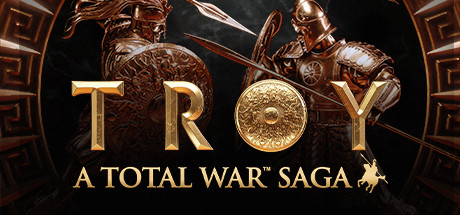Of myths and no monsters
Type: Single-player, Multiplayer
Genre: Strategy
Developer: CREATIVE ASSEMBLY
Publisher: SEGA
Release date: Aug 13, 2020


The Total War series turned 20 last year, and in its long history there’s been a fare few changes, some small and some big, though the defining feature of the series has remained roughly the same since the original Shogun, the split between a relatively deep strategic layer where you manage your nation and recruit troops, and intense real-time tactical battles where blocks of troops face off against each other.
A Total War Saga: TROY is a strange entry in the series. It tries to split the difference between the older (somewhat) historical games like Shogun and Rome and the more recent Fantasy entries based on Warhammer. It has mighty mythical heroes like Achilles, Paris, Hector and Agamemnon, but at the mythical monsters are represented by exceptional people rather than actual monsters.
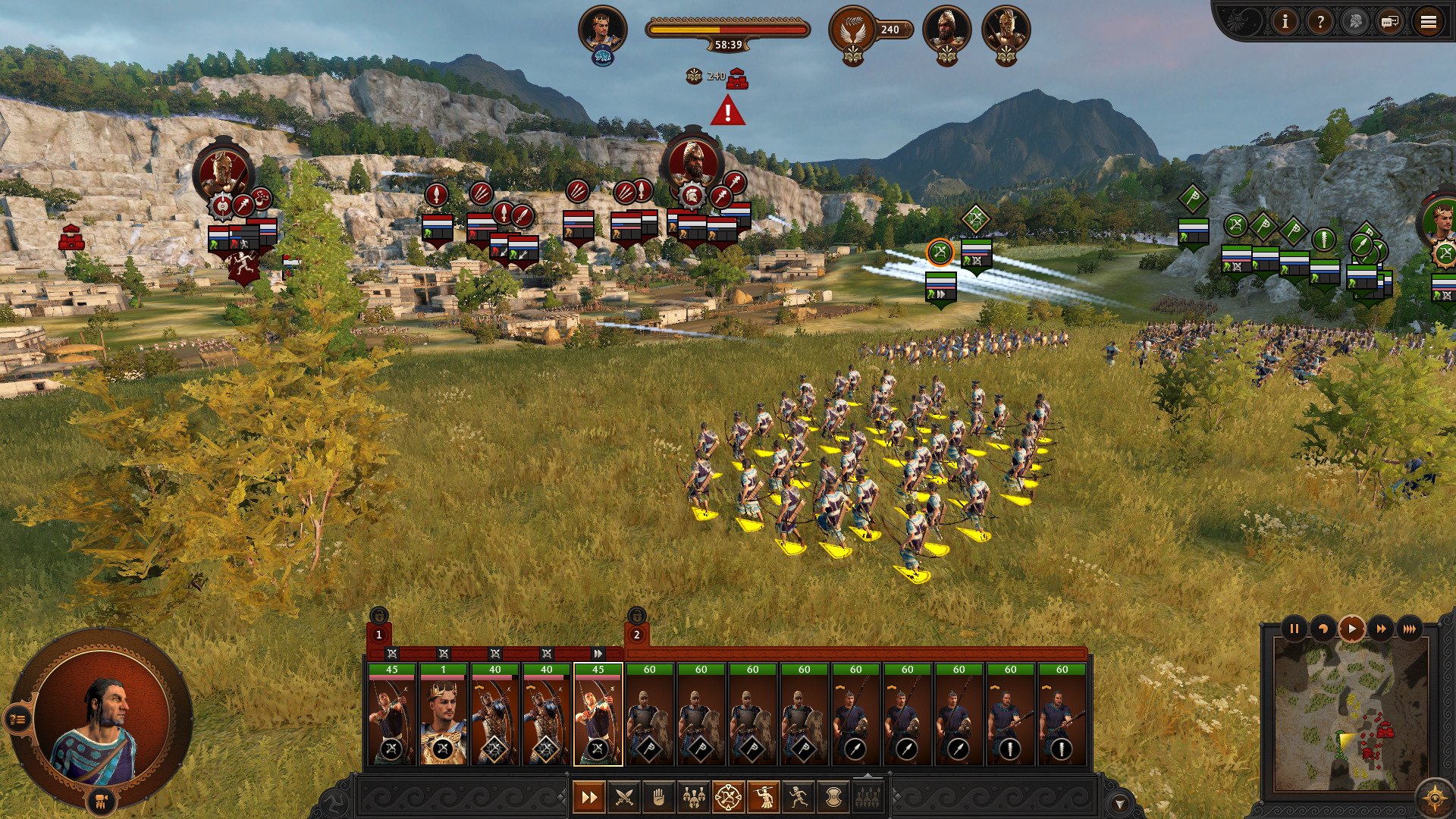
Story & Setting
Total War Saga: TROY is set in a mythical bronze age Greece, during the time of the Iliad. Paris has carried away the beautiful Helen to Troy, and war is looming as Achilles swears to bring her back to Sparta. On both sides of the Aegean Sea armies are mustering, preparing for the inevitable conflict. Though unlike in the Iliad the siege of Troy will have to wait, as both sides has to conquer their surroundings first.
And so starts Total War: Troy. No matter which on the factions you choose to play Helen has been taken away from Sparta and brought to Troy. There are two “superfactions”, the Danaans (probably more famously known as the Achaeans) and the Trojans, each of which has four nations in them (plus any DLC factions. There’s at the time of writing also a DLC that adds a third superfaction). These represents the two main sides in the war, with the Trojan factions being more likely to band together with other Trojan factions, and Danaan factions being more likely to make alliances with other Danaans. There are also a fare few neutral factions, that are just there to be conquered or traded with.
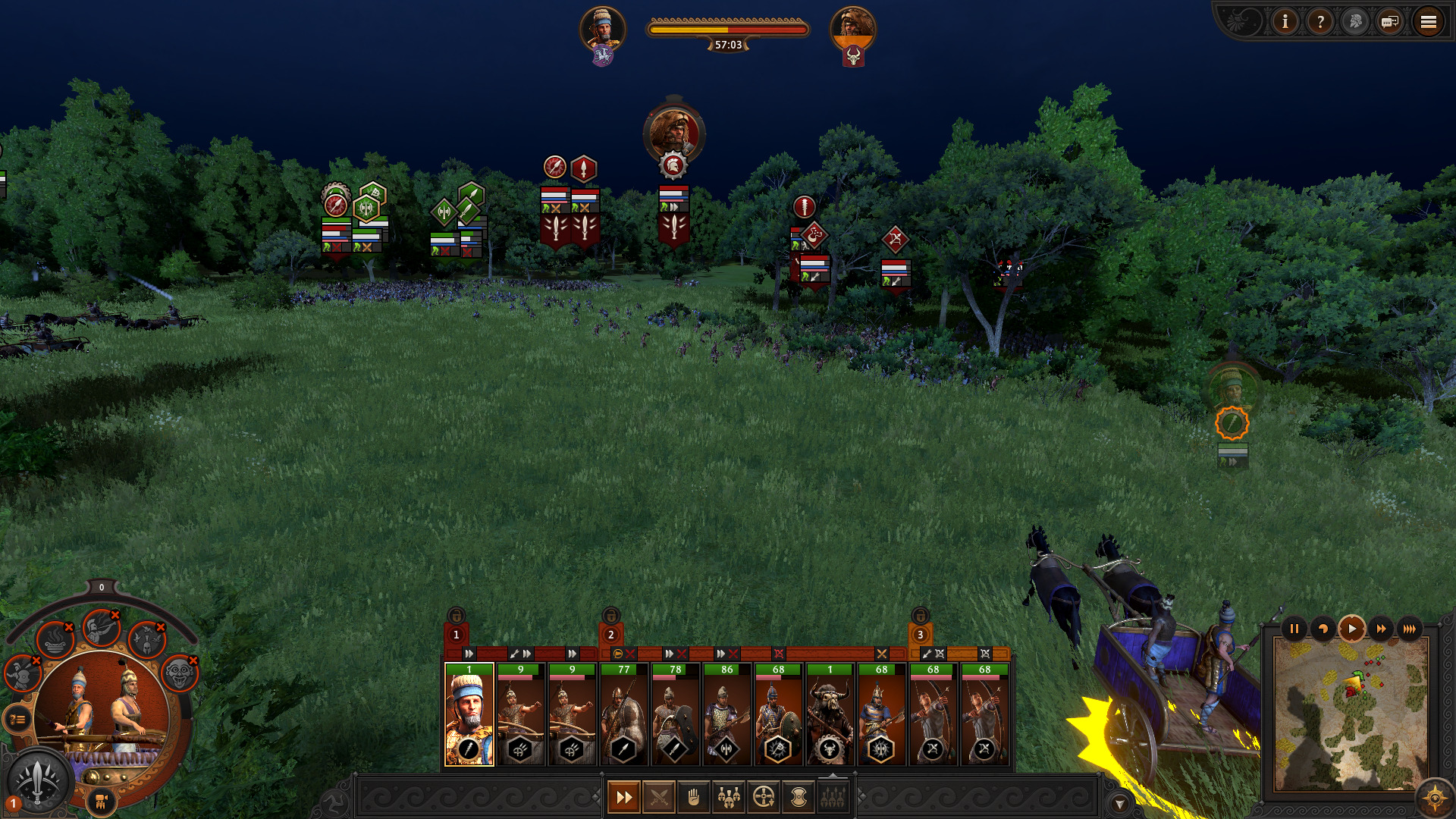
The game map covers a comparatively small area (at least compared to other Total War games), with Crete being the southernmost part of it, and current day Istanbul being as far north as it goes. All of Greece is covered, plus some parts to the north, as well as the westernmost parts of current day Turkey.
As the game is set during the bronze age armies are armed with weapons and armour of that time. There’s also a not many horses being used, with the few horses that are here pulling chariots rather than carrying people on their backs (at this time they had not managed to breed horses that were suited for carrying someone into battle). Soldiers are wearing bronze armour, and are armed either with long spears, clubs, swords, slings, javelins or bows. Different factions have differing army compositions, but none stray far from the basics.

There are “mythical units” in the game, though they’re not represented by big impressive monsters, but rather people. Centaurs for an example are people who are doing something as crazy as actually riding horses into battles (they’re an exception to the no horse riding rule), and the cyclops is just a really big guy with a big weapon and a baby elephant skull on his head (if you’ve seen an elephant skull you might have notice that they have what looks like a big eye in the middle). Harpies are just javelin throwers with weird bird wings in their hair, making them look like Johnny Depp in that movie we all probably just want to forget even exists.
The gods are also taking a more active role, and are treated as real in the game. Pray to the gods and you might get bonuses, ignore them and they get grumpy. Or that is at least what the game wants you to believe. Most of the reports you get are written in an in-universe way, as if the people giving you the report believe that the gods are the reason why things happen.
There’s in other words a weird mix of history and myth in this game. On the one hand the armies are somewhat believable (at least more believable than the Egyptians were in the first Rome: Total War, those guys where time travelers from 1500 years before the game was set), but then you have fantastical individuals who are able to take on dozens of regular soldiers and come out of the fight with a mere scratch. The game also takes a very Greek-centric view of the region, which makes sense considering this is based on the Iliad, but any historians might gnash their teeth when they see that everyone in the region seem to be happily worshipping the Greek gods.
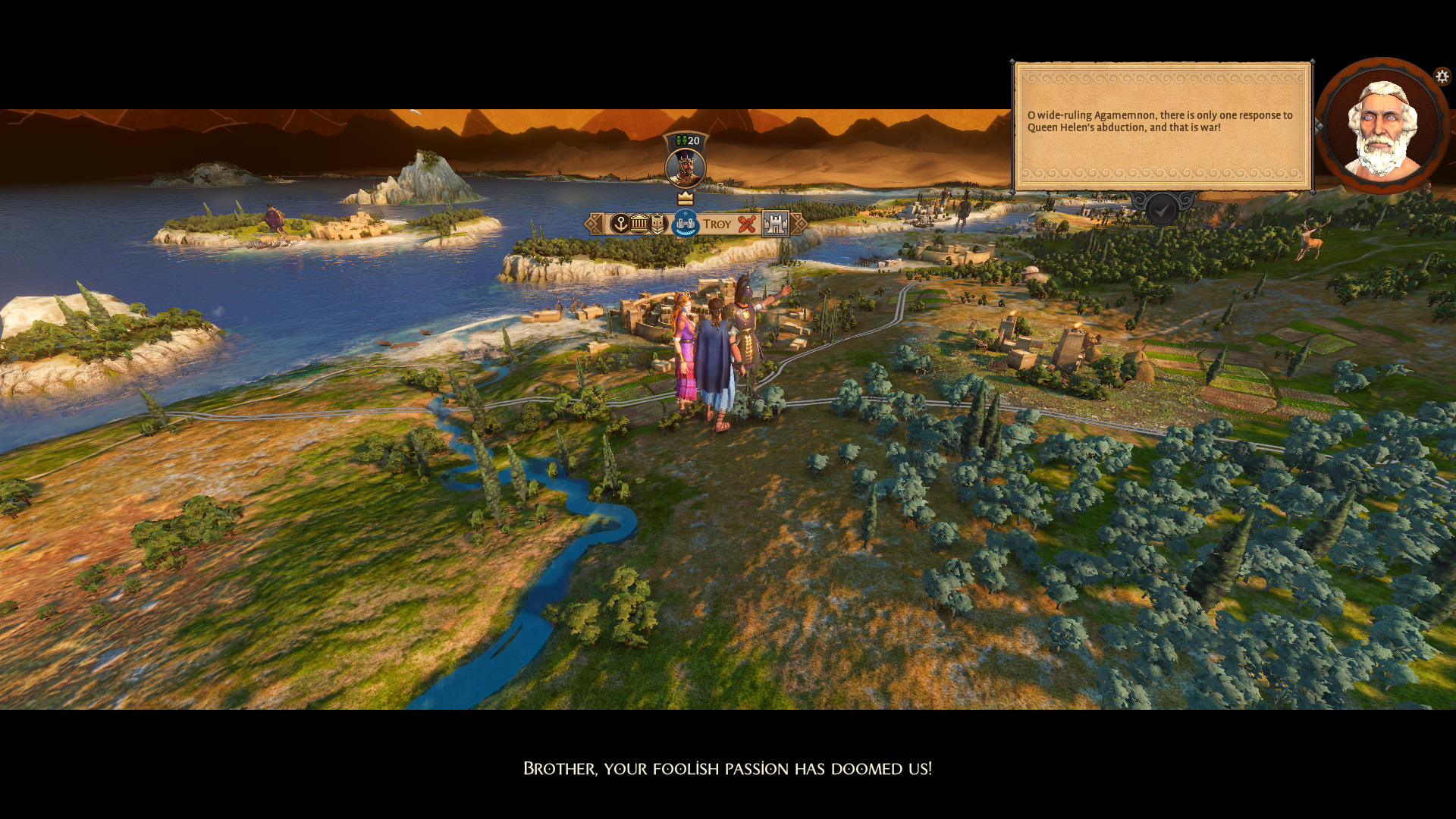
Presentation
A Total War Saga: TROY is running on a now pretty old engine, but it still looks remarkably good. And somehow the system requirements are so low that you can probably run it on a mid-range computer from 2010.
The game is split into two parts, a strategic mode with a map of the region, and a battle mode set on smaller self-contained battle maps. The battle maps are what tends to get the most attention in total war games, as here’s where the armies will face off against each other, and the battles look great. Large infantry blocks fight each other, with each individual soldiers not necessarily being identical to the one next to them. Animations are mostly smooth, though there’s a bit of janky movement at times, particularly when soldiers try to turn on the spot, and despite how many soldiers there can be on screen at once they have surprisingly detailed character models and textures, with interesting looking equipment. Chariots leave a trail of destruction behind them as they charge into infantry formations, and the heroes themselves leap into battle in a slightly exaggerated but interesting way. And when two heroes face each other the other soldiers make room for the duels. You can sometimes see circles in the middle of ongoing fights where just two individuals are duking it out, while the nearby soldiers look on. Troy might not quite have the same variety as some of the other recent Total War games, but what’s here looks great.
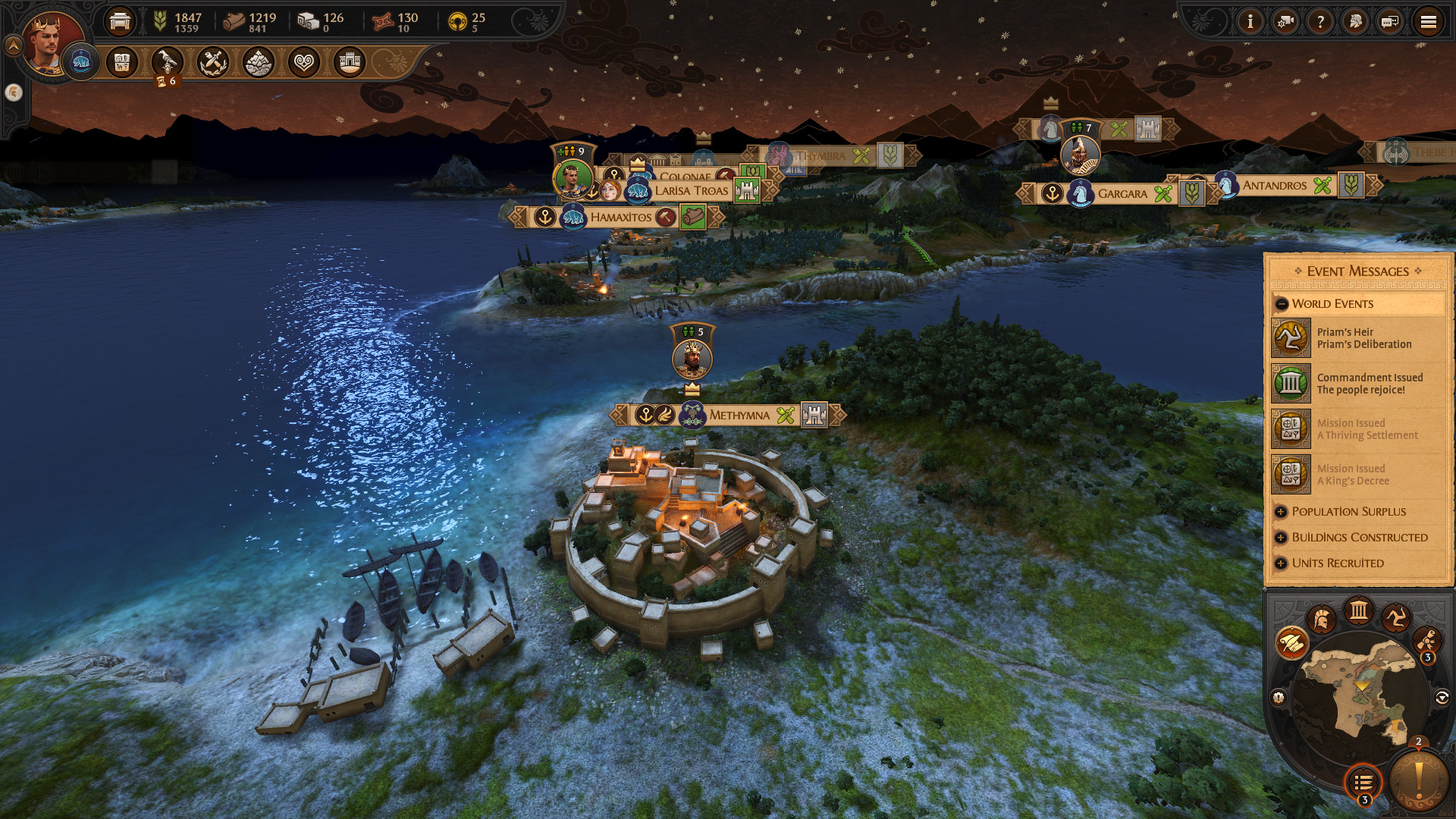
The world map might well be the best looking one in a Total War game thus far. It uses more saturated colours than the more “realistic” looking Total War titles, and the effect is quite striking. Also, the unexplored areas has an almost parchment-like look to it, with writing and illustrations, and the distant skybox, look like something that could have been painted on a vase. It all adds up to a really good looking world map.
Total War: Troy is no slouch in the sound department either. The soundtrack is overall quite good, with some of the tracks being really good, and they all fit in with the general theme of the game, and the games sound effects, be it the sound of fighting, or just the small confirmation sounds that plays when you perform some action, all fit in well. Most of the voice clips are also good and give enough information without sounding annoying.
There are some minor readability issues that pops here and there though, like with some of the icons they’ve selected to represent units. A unit of militia and a unit of heavily armoured soldiers swinging clubs both have a club as their icon, and though their icons are not identical, in the heat of the battle it’s easy to mistakenly send the wrong unit into a fight.
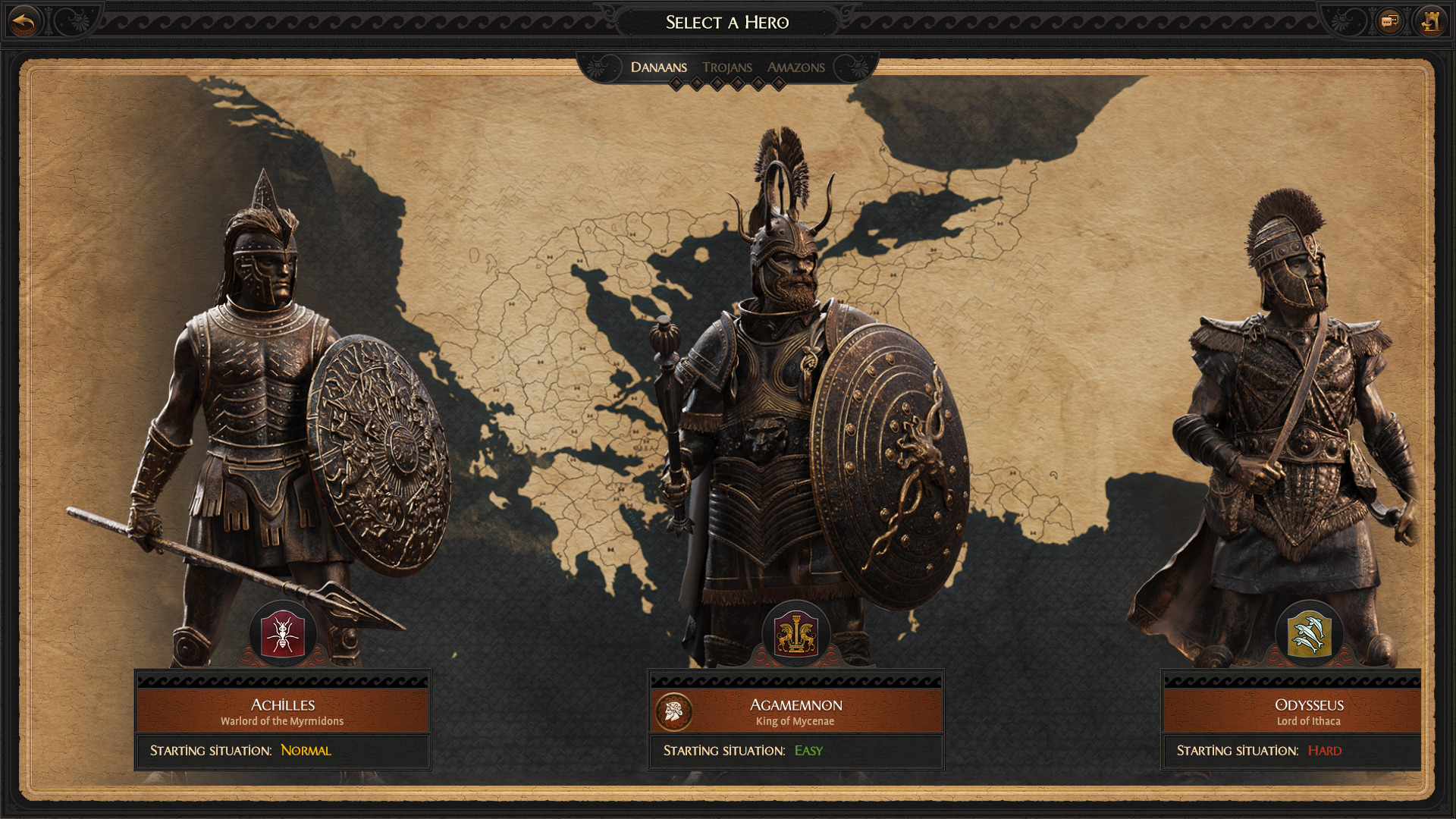
Gameplay
Total War veterans will find that a lot of things work just like you would expect them to. You move armies around on a large map in a turnbased mode, develop your cities, and when you run into an enemy army or try to attack one of their cities the game switches to a real time tactics mode. Developing cities work just like it has for a long time now in the Total War series, and there are no real surprises with combat either. But that’s not to say that Total War: Troy does not bring anything new to the table, and veterans might be caught off guard by some of the things Troy does differently.
But let us start at the beginning. The first decision you’ll have to make when playing Total War: Troy is who your main hero will be. Your main hero determines a lot of things, not just which mighty warrior you’ll control on the battlefield. Different heroes have different starting locations, different diplomatic relations and different unit rosters, as well as different fighting styles themselves. Different heroes also have their own unique mechanics. Paris for an example needs to appease Helen, and if he manages to keep her happy she gives a boost to the province she’s in, but if she’s angry she’s at first lower the happiness of the province and then your entire empire. Your starting hero also determines what troops you have available to you, with many units being common between heroes/factions, but all missing at least some key units, while having some more unique units of their own. Don’t expect Total War: Warhammer levels of faction variety here, there are still more similarities than differences between them, but at least they’re more varied than Shogun 2.
Once you’ve picked your hero it’s time to play the game. You’ll be dumped onto the world map with a small army, a few cities and a starter quest (to kill some ne’er-do-wells). It’s really on this screen that the game is won or lost. Here you’ll develop cities by building new buildings, moving armies to take land or fight enemies, research new technology and engage in diplomacy.
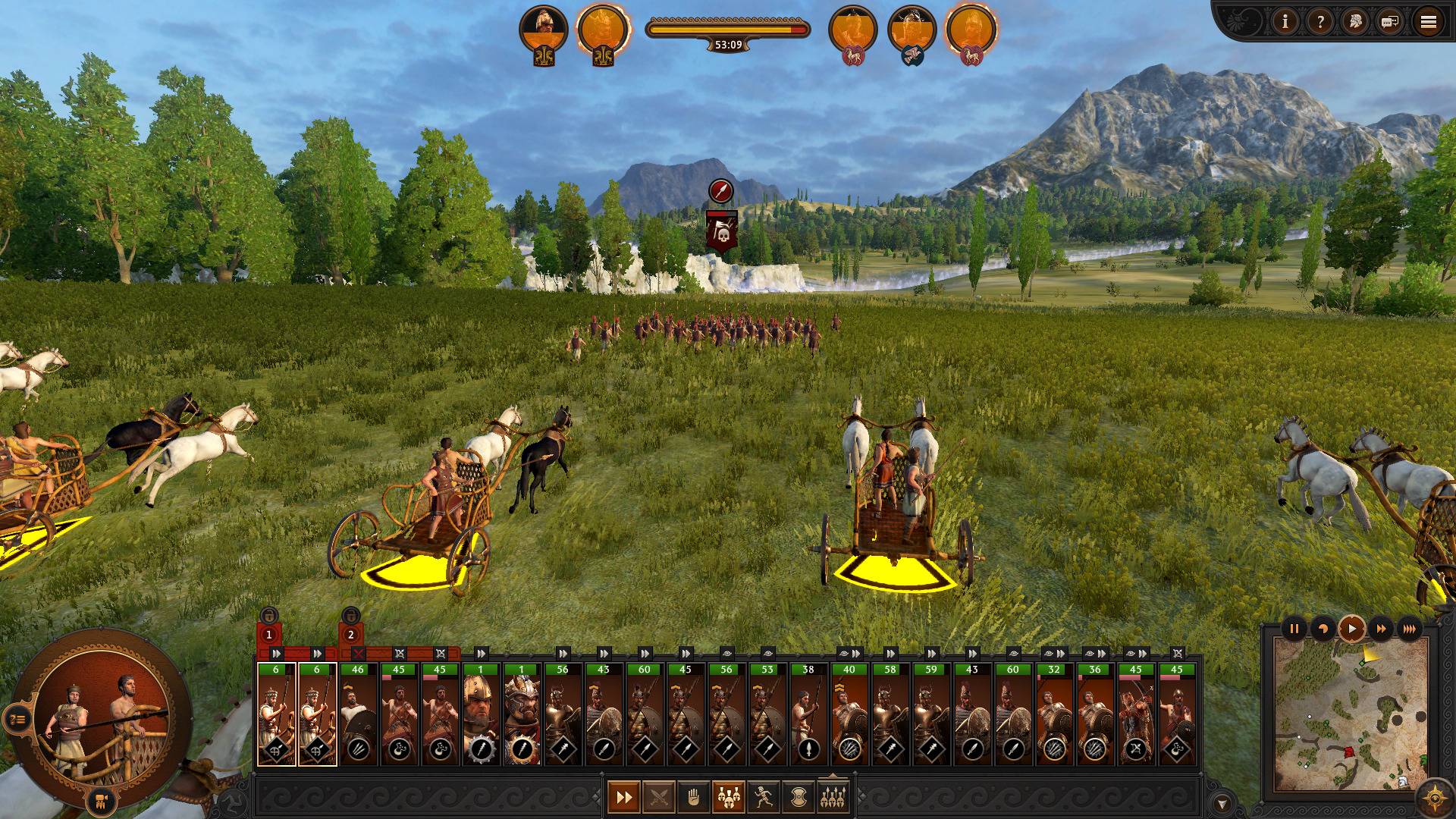
Managing cities is simple, though there’s some depth to it. Click on the city and you’ll be presented with a view showing all the cities in the province, and what they contain (if they’re yours). If there’s an empty spot you can build something there. Each province has a capital which can have higher level buildings, and smaller cities which are limited to lower level buildings, though in able to build higher level buildings you need to grow your population, which prevents you from just building the most powerful buildings right away. Different buildings have different effects, some produce resources, some make the population happy, some allow you to recruit specific units and some are there to make the gods happy as well as a few other. What you build, where you build it and when you build it are all important factors to consider. Buildings are also not free, but require specific resources to build (wood, stone and gold in varying quantities). Higher tier buildings tend to require not just more resources, but rarer resources. Early buildings often just require wood, but upgrading them to a higher tier, or build something special and you’ll have to have some stone and even gold on hand, resources that you might have to trade for.
Army management is not too dissimilar to city management. Click on an army and you get to see what units are in it, and if you’re in your own territory you can recruit new soldiers (up to a maximum of 20 units of soldiers per army). What units you can recruit will depend on the buildings you’ve built. Early on you’ll just have access to simple militia, slingers and unarmored spearmen, but later in the game you’ll have access to heavy chariots, spearmen clad in full bronze armour and elite archers, to name a few of the available units. Units do cost resources though, and unlike buildings, they also have an upkeep cost that you’ll have to pay every turn. Early units usually just cost food, but later units costs bronze and some even gold. Bronze is a resource that tends to be in really high demand after a while, as armies eat up a lot of it.
Different areas produce different resources. Every non-capital city produces a single specific resource, and buildings can increase the amount of that resource that the city produces. But if you don’t have access to regions that produce the right resources (or at least enough of them) trade might be a good option. Total War: Troy is the first Total War game to put an emphasis on trade. In other games you’ll get more money (the only production/upkeep resource they tend to have), which is nice, but in Troy you really need to find other factions who are willing to trade resources with you. This makes staying on good terms with at least some of the other factions extra important, and going on a conquest spree is likely to make you resource starved, at least until pretty late in the game. Forming and maintaining alliances is also more important than ever, as that means that you’ll have friends who won’t just guard your back, but which might be willing to part with some of that sweet sweet bronze when you need it the most.
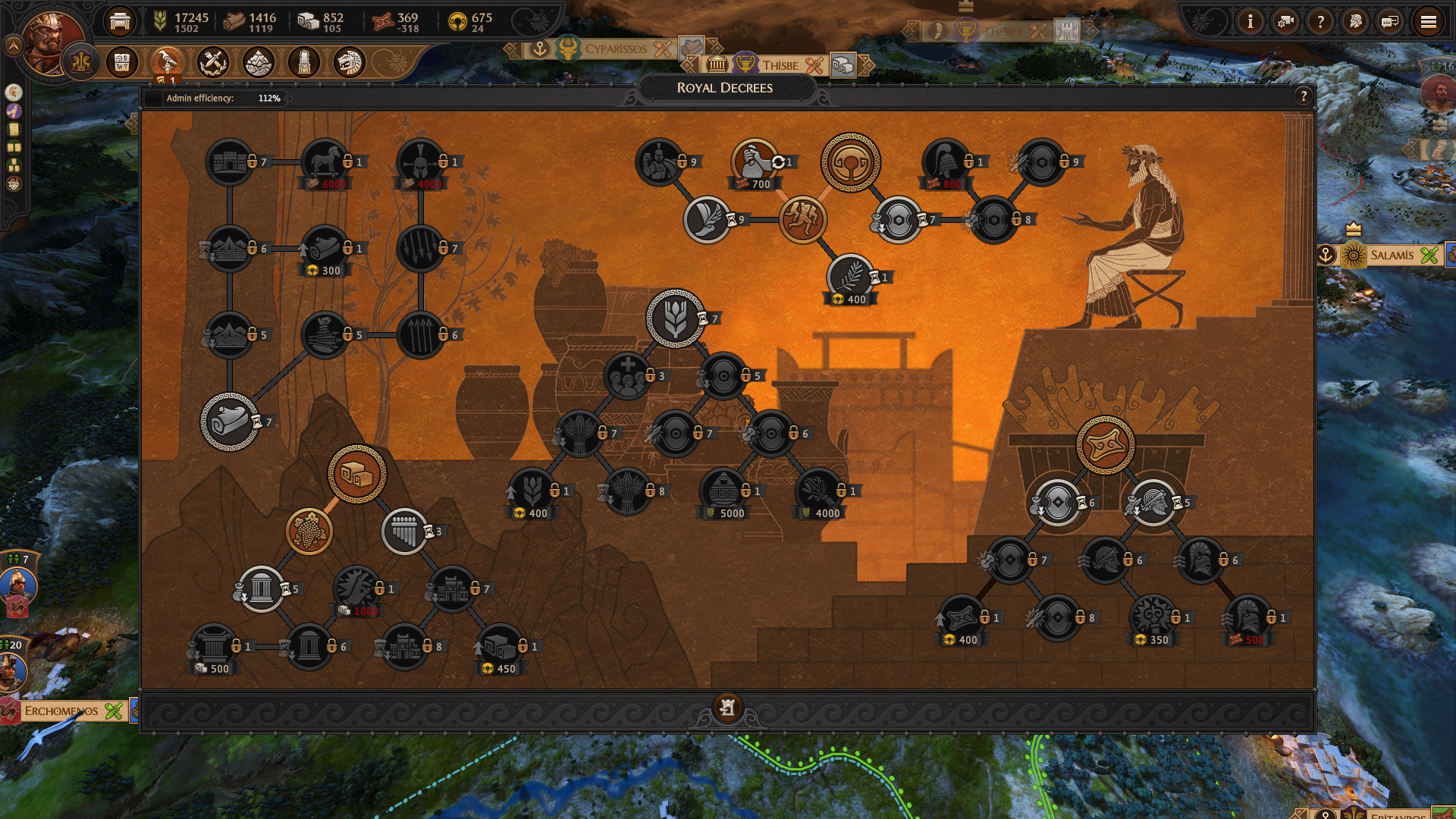
Research is not as involved as army or city management. There are a few tech trees, one per resource, and the first thing you research in each tree will give you a small trickle of that resource, where the rest are different upgrades to your faction. These vary a lot, some improve the damage of specific units, some make your armies move faster, others make your buildings cheaper and some make your citizens happier. Research takes time, often quite a few turns, though there are a few research topics that instead cost a large amount of a given resource and have a short research time.
No Total War game is complete without tactical battles. And they both look and feel a lot like the battles in other recent Total War titles, though there are subtle differences. Soldier usually move in tight formations, and come equipped with a bunch of different weapons that are good against different targets. Ranged weapons tend to be great against unshielded units, but suffer against ones that carry shields, chariots don’t want to get bogged down in fights against spearmen and high armour piercing weapons are good against armoured targets. The balance is not always entirely obvious, like when do you want to use units with clubs and when do you want to use units with swords? But weapon matchups is far from the only thing that matters in combat, a unit of elite troops can beat a unit of conscripts even if they have a “bad” matchup, and even a low quality unit with a bad weapon matchup can still put a big dent into an elite unit if they can attack their flanks. Some units are also better when storming into combat than during sustained combat, like chariots, a unit which is at its best right after they initiated combat.
Combat is also not just about killing enemies. While a dead enemy soldier won’t cause you any more trouble, it’s often more effective to try and just make them run away. As units take losses, or other bad stuff happens to them (or maybe they just saw some crazy guy wearing the skull of a baby elephant?), their morale will drop. Once it drops too low they’ll turn tail and run. Morale does recover over time though, and a fleeing unit might decide to return to the fight. In fact that’s likely to keep happening in combat, units run away and then come to their senses after a little while and return to the fight. Of course you can try and cut down a fleeing enemy (they can’t defend themselves, so they’re easy targets) but units giving chase can in turn easily end up getting out of position.
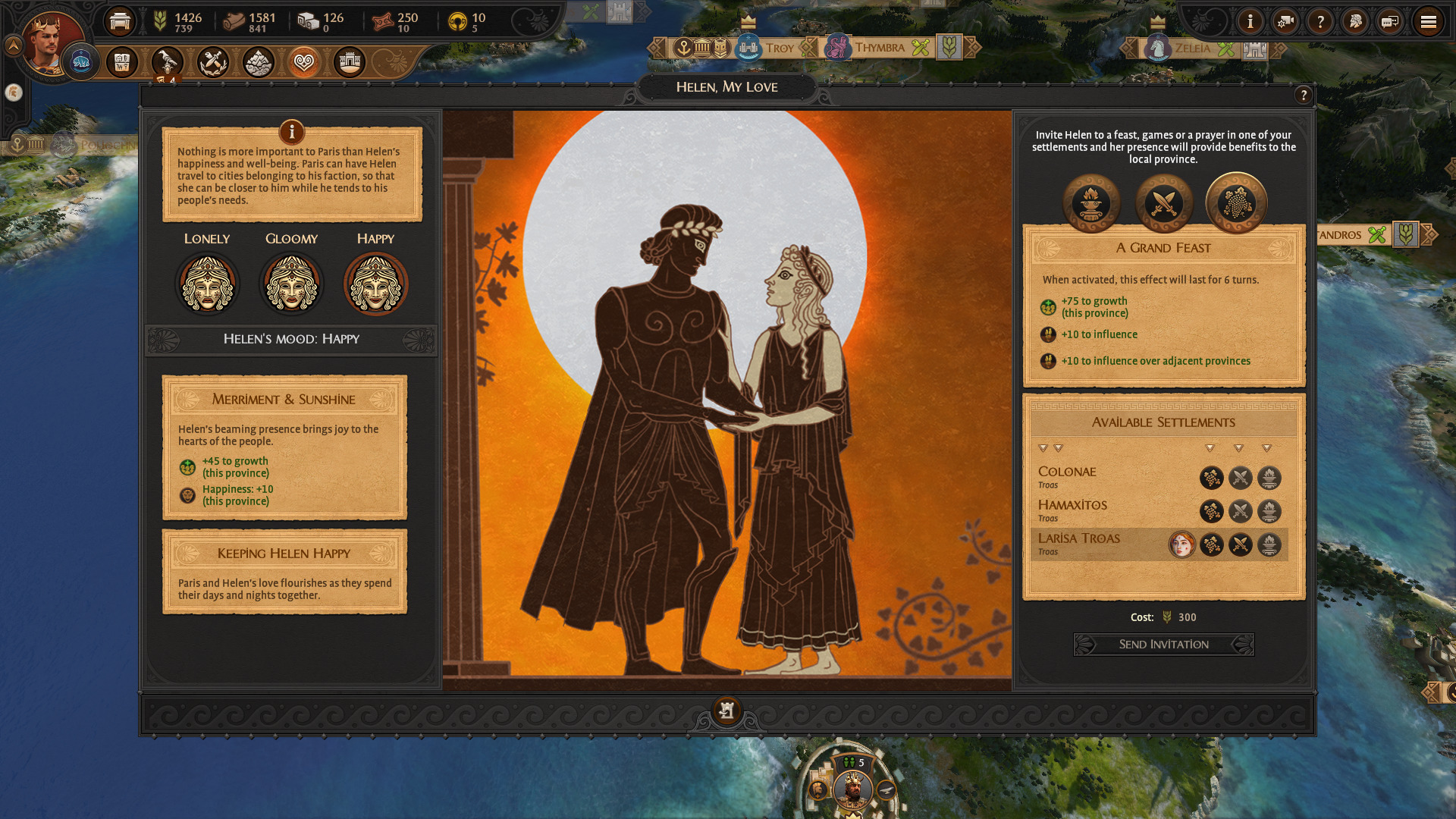
Heroes are a special kind of units. They’re single entities that have the combat power of entire blocks of troops. In battle they can strengthen any place in your lines that are faltering, and they even give a boost to their surrounding troops. They’re not invincible though, and due to how the game calculates if an attack hits or not (attacks from the sides or behind are more likely to hit) a lone hero can struggle if going in on their own against a group of enemies, as they’ll find themselves surrounded. But if supported, a hero can make all the difference. Heroes also level up after battles and get stronger, with each level they gain letting you spend a skill point. Though Troy sadly has one of the least exciting skill trees of any Total War game that uses them, with each new level unlocking a new skill “tier” where you get to pick between one of two skills. You can also upgrade older skills, and if you pick one skill on a tier you’ll permanently lock yourself out of the other. For a game where heroes takes such a central role, the actual leveling up and managing of heroes feel surprisingly under-developed. Even Total War: Rome 2 did this better.
Troy does have some annoyances though. For one the AI will keep offering you bad trade deals that make absolutely no sense, and you’ll still have to click no. That would be fine if you got one every second turn, but you can often get several in one turn. The AI really should base their offers not just on what they need, but what you could possibly want. You get information about what the AI has a surplus of, so it would not be weird if the AI knew that if you have a surplus of wood, you’ll not want to get more wood for an example. Also, as seems to be the norm with Total War games the tutorial is a bit lacking. This would not be a good first Total War game, as the tutorial is even worse than usual.
With a game as complex as Troy there’s of course more going on than mentioned in the review, but these are the most important aspects. For Total War veterans the changes to the resource system is likely to be the thing that sticks out the most. Battles also take a little bit longer than usual, as units don’t hit quite so hard relative to how much HP they have as in say Rome II or Warhammer. Units that are good at giving chase to fleeing enemies are also rarer, so fleeing troops are more likely to be able to return to the fight, thus further prolonging battles.
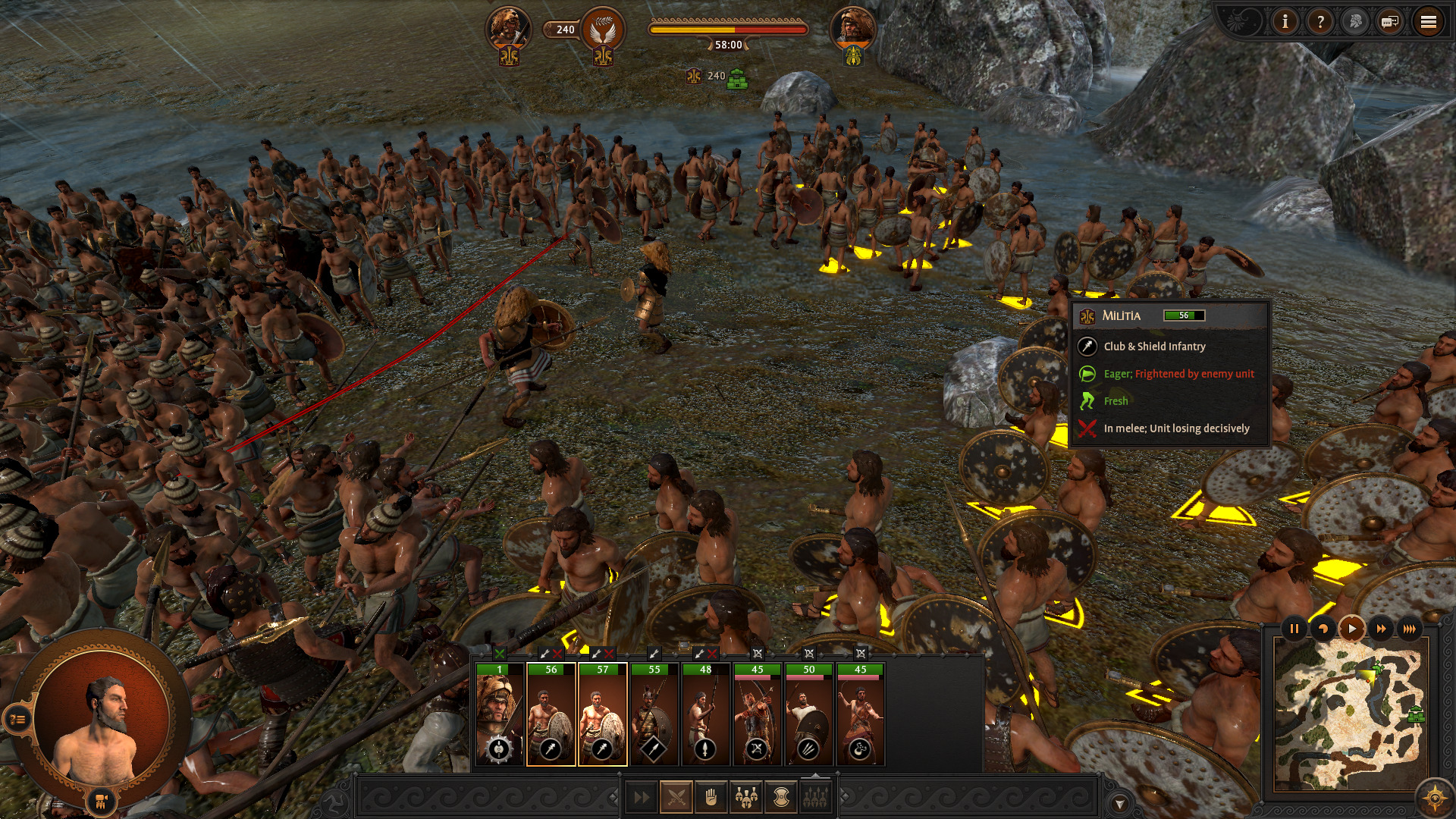
Closing Thoughts
A Total War Saga: TROY feels like a side project, like a smaller game made so they could experiment with some ideas and see what works. It lacks the scope of most other Total War titles, though that is usually the case with games bearing the name “A Total War Saga”. That is not to say that Troy is a bad game though, just that it lacks the scope and staying power of one of the big Total War titles. The game is frankly beautiful, and combat is as satisfying as ever. The new resource mechanics also gives the strategic part of the game more depth than most past Total War games, and I hope this is something that they use in future games.
Also, anyone who played the game at launch and found it terribly unbalanced might want to give Troy a second look. The main offender, chariots, have been toned down (but not to the point where you don’t want to bring them) and many of the other little blemishes the game had has been fixed. Troy is still not the Total War game I would recommend to someone new to the series, but veterans might find it refreshingly different, yet at the same time comfortingly familiar. It strikes a good balance between the old and the new. Also it runs on pretty much anything capable of running a modern version of Windows, which is an impressive feat on its own, considering how good looking it is.

